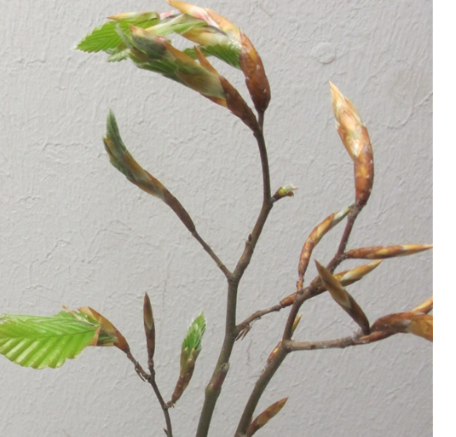Bud dormancy under climate warming
Warming-induced changes in bud dormancy and their effects on leaf phenology in common European tree species.

Kontakt: Andrey Malyshev, Ilka Beil
A tree’s growing season length is largely determined by the timing of budburst in the spring and leaf senescence in the fall. Warmer spring and fall temperatures have been closely linked with advanced spring leaf-out and delayed plant senescence, respectively. However, a recently observed reduction in the rate of advancement of spring green-up per degree of warming reflects a nonlinear response of plant phenology to climate warming. Future projections indicate that for certain species, advancement in spring leaf-out can stop or even be delayed. Fall senescence is much more unpredictable, with new evidence showing that it can be advanced following an earlier budburst in the spring and be delayed by warmer fall temperatures. Understanding the mechanistic causes of species-specific shifts in phenology in response to climate change is thus essential to better project future tree growth, potential community composition changes and plant-animal interactions.
Plant phenology under climate change has mostly been addressed in an observational manner, correlating historical phenological dates with temperature records. A more mechanistic approach, addressing the core causes of phenological changes is lacking. Bud dormancy, quantified as the time required for budburst to occur under optimal growing conditions is initially affected by temperature and in turn affects leaf phenology. As a result, bud dormancy changes have started to be incorporated into phenological models and have led to improved budburst date predictions. The species-specific photoperiodic and/or temperature control of bud dormancy induction is not known however. The experiments in this project will thus primarily focus on:
a) the relative influence of photoperiod and temperature on bud dormancy depth
b) warming-induced changes in bud dormancy depth
c) legacy effects of spring phenology timing on subsequent leaf senescence and spring budburst dates
Among- as well as within-species variation will be quantified by conducting the experiments on common European tree species. Experimental results where phenological changes are not merely left to temperature-driven “black box” effects but are linked to specific changes bud dormancy will deepen our mechanistic understanding of plant phenology and will be a valuable basis for future phenology models.
